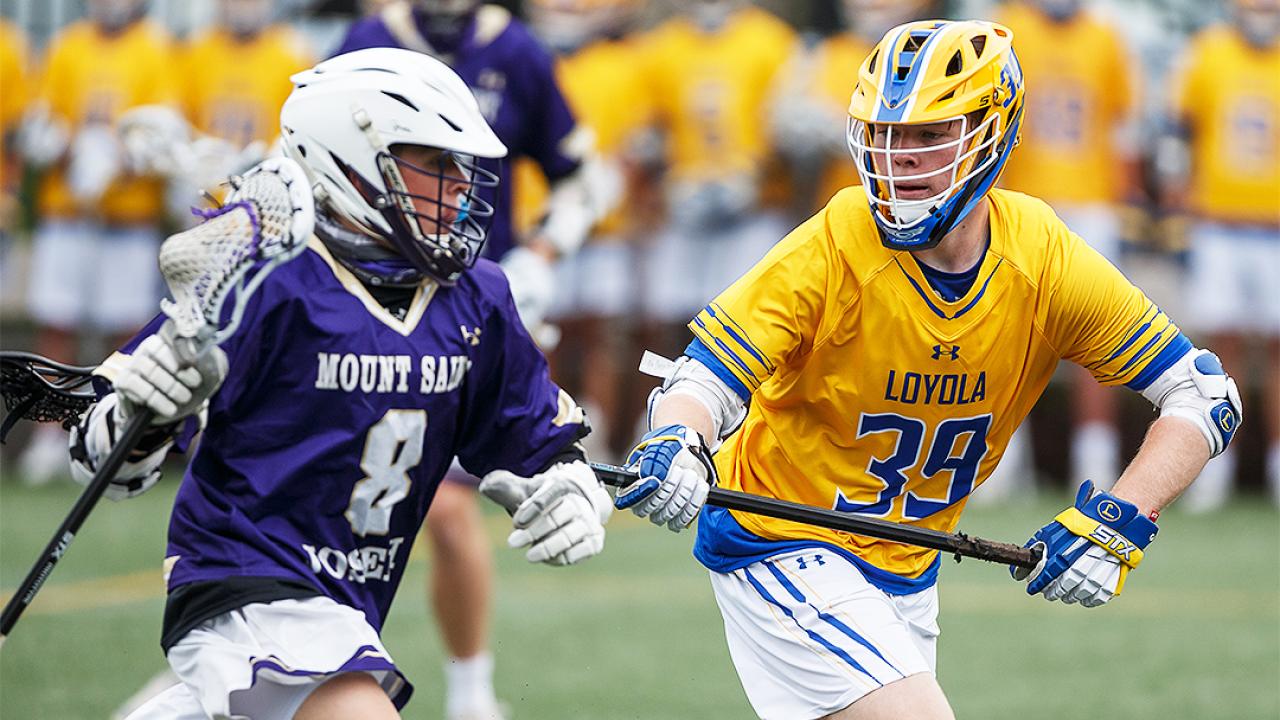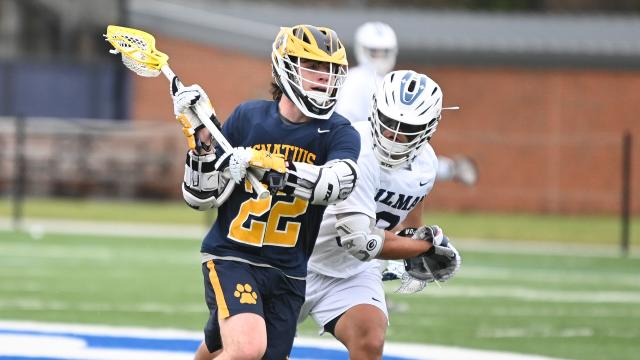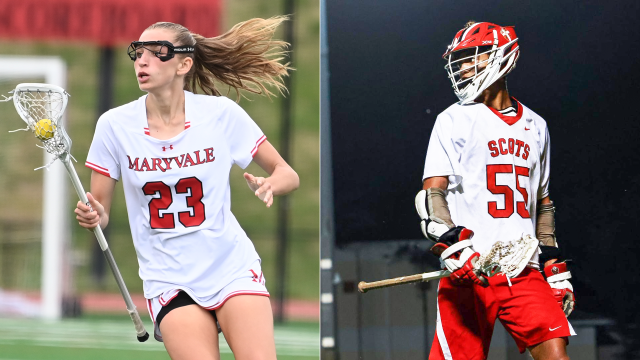
Those Who Rushed to Peter Laake's Aid Detail How They Saved His Life
A sigh of relief broke out from the group of emergency professionals attending to Peter Laake when the Loyola Blakefield freshman defender opened his eyes.
Laake suffered commotio cordis after being hit by a shot in the first quarter against McDonogh in a Baltimore-area high school boys’ lacrosse game last Friday. Commotio cordis causes sudden cardiac arrest in an otherwise healthy heart after a blow to the chest area. It is fatal 75 percent of the time, according to the US Commotio Cordis Registry, and the eerie hush at Loyola’s Hargaden Field exposed everyone’s worst fears — until their prayers were answered.
“It’s a whole lot easier to move forward knowing he’s alive,” Loyola athletic trainer Jeremy Parr said. “It’s a good story instead of a tragedy.”
Laake was revived thanks to the readily available automated external defibrillator (AED) carried by Parr, the swift and well-orchestrated response and the help of an absolute dream team of trainers, nurses and doctors on site to administer emergency care.
“With any potentially tragic circumstances, the key is, you have to have the right personnel, the right equipment and a good emergency action plan to execute in any potential situation,” Parr said. “This is a terrible tragedy that could have happened that was avoided because we had trained medical professionals on site, we had the absolutely correct equipment that needed to be there and needed to be accessible in immediate fashion and we had an action plan that worked with who we had there and with great help from other medical professionals that were on scene and wanted to lend their helping hands.”
If any of those critical pieces — most importantly the AED, in Laake’s case — had not been in place, the outcome could have been different. Someone suffering commotio cordis must have their heart shocked back into rhythm.
“There can be lots of other causes of cardiac arrest, but with this one, you absolutely have to have the AED and someone who’s willing or trained to enact that plan,” Parr said of the dangers of commotio cordis. “By the time the EMS and the AED they have gets there, unfortunately, it’s usually too late.”
To enhance player safety, US Lacrosse has long advocated for the presence of an automated external defibrillator (AED) at all lacrosse practices and games. To help support that effort, US Lacrosse has periodically provided grants to member organizations to acquire AED units.
The American Medical Society for Sports Medicine recommends that an AED should be accessible within a minute of a playing field so that a shock can be given within three minutes of an athlete’s collapse. Loyola has 10 on campus with the goal that no person could ever be more than two minutes from an AED. There is a 10 percent decline in survival rate for every one-minute delay in getting shocked by an AED.
“An AED doesn’t do any good if it’s not accessible in an easy, quick fashion,” Parr said. “If they’re there, it’s because of some mandate or law to have one on a school property, but they might be locked up.”
A lack of an AED led to the tragic death of 14-year-old Louis Acompora, a goalie from New York who passed away from commotio cordis 21 years ago in his first high school game after a routine save. Rescuers did CPR on Acompora, but it was more than 12 minutes after his collapse before defibrillation started. US Lacrosse assists in the CPR training of adults to help prepare for potential emergency situations.
The Louis J. Acompora Memorial Foundation was founded by his parents, Karen and John Acompora, to improve sports safety and focuses on the importance of getting AEDs into schools as well as pre-screening athletes for heart issues. A 2020 study of the National Emergency Medical Services Information System estimated more than 23,000 cardiac arrest events among youth from an examination of 2016 statistics. Laake now is one who survived commotio cordis.
“When you see that, you know everything you’ve done over the years is paying off, and we’re not burying some 14-year-old young boy that doesn’t deserve to pass away playing a sport that he loves,” said Karen Acompora, who is also chair of Parent Heart Watch, which focuses nationally on preventing sudden cardiac arrest and sudden cardiac death in youth. “Andrew’s Law,” enacted in 2006 in memory of another lacrosse goalie, Andrew Helgeson, who died of sudden cardiac arrest in a game, mandates the placement of AEDs in all Maryland high schools and all school-sponsored athletic events. Friday’s incident in Baltimore was a reminder of why such safety measures are put in place.
Laake was hit by a shot after sliding to a McDonogh player near the end of the first quarter. He staggered briefly before falling away from the team sidelines, in the direction of the spectator stands.
“I remember taking a couple steps, and then I remember getting super dizzy,” Laake said. “I don’t even remember starting to fall. I just remember getting dizzy, and then I sort of blacked out.”
Peter Laake isn’t the sort of kid to just fall down. He’s 6-feet, 200 pounds and nimble on his feet — not clumsy at all. He was starting on defense in an MIAA “A” Conference showdown with rival McDonogh, where his two younger sisters attend.
“He’s an incredibly good lacrosse player,” Loyola coach Gene Ubriaco said. “He’s a very big young man. He’s one of these rare athletes who has a big frame, great feet. He’s like a 6-handicap golfer and a shooting guard in basketball. He’s a very gifted and unique athlete, and obviously he’s unique in a lot of ways now.”
Parr and Aaron Tracy, a fellow at University of Maryland serving as Loyola team doctor this year, hoped Laake only had the wind knocked out of him as they scurried out onto the field. Others thought he may have suffered a mechanical injury, like a knee. Bob Dudas, father of McDonogh midfielder Jack Dudas, who is the Chair of General Pediatrics at Johns Hopkins All Children’s Hospital in St. Petersburg, Fla., hesitated to leave the stands initially, but he was worried.
“The way he fell was terribly concerning,” Dudas said. “It was different from someone injured who seems to be in pain and then kneels down, or the player who is pushed or trips. Peter collapsed face first without trying to break his fall.”
Parr and Tracy found Laake gasping for air. Agonal breathing is a symptom of a severe medical emergency like stroke or cardiac arrest. Tracy and Parr’s student intern, Erin Brown, together rolled Laake onto his back. When they could not find a pulse, they suspected commotio cordis and sprang into action. Others, including Laake’s parents, joined the scene.
“It was obviously a parent’s worst nightmare to see your child out there unresponsive,” said Laake’s mother, Carron. “I’m not quite sure what I said. I’m sure I scared a lot of those boys out there with my reaction. You could have heard a pin drop, except for me reacting.”
Parr had yelled immediately for two things — to call 9-1-1 and to get the AED. Jared Braverman, McDonogh’s trainer traveling with the team, was also out on the field to help and ran to retrieve the AED from Parr’s training bag on the sidelines while instructing McDonogh’s student trainer, Hunter DeCeasar, to call 9-1-1. Tracy, a former lacrosse player at Kenyon College who went on to play for the Israeli national team, began CPR. His compressions were, by all accounts, impeccable.
“It was amazing how they talked and communicated,” said Laake’s father, Pete. “It was organized chaos.”
Braverman organized crowd control around Laake after returning with the AED. Dudas was searching for a pulse in Laake’s wrist. A pair of nurses also came from the stands to help when they saw compressions beginning. Candace Cook, mother of Loyola freshman Mason Cook, is a nurse in the critical care unit at Union Memorial Hospital. She searched for a carotid pulse and helped apply the AED pads.
“It was hard for me,” Cook said. “That’s one of my son’s best friends. To see a kid that you know, it’s a little different than strangers in the CCU.”
Missy Lala, whose son Thomas is a sophomore at Loyola, kept track of the timing for when the paramedics would arrive. She also pushed the button to start the AED shock.
“I wanted to make sure they had the AED out and were able to use it,” said Lala, who works in the recovery room at Greater Baltimore Medical Center. “It was a very well run code. It was a very well executed effort by the training staff and doctors. I was laying in bed that night and thinking, ‘I don’t think there was one thing we could have done better.’”
Parr took the lead of the rescue team. Ensuring that the AED was properly used and helping to communicate through the rescue was Kyrle Preis, the former fire chief of Baltimore County and father of Keegan Preis of Loyola Blakefield. Dudas found a pulse after the initial shock, and shortly thereafter, Laake opened his eyes and seemed more alert than anyone would have anticipated.
“It seemed that he was having a bad dream, and then all of a sudden just woke up from that bad dream,” Tracy said. “He was about to sit up. He was a little confused at that point. We made sure he stayed down because we didn’t want to cause any more harm, and we wanted to make sure his pulse was at rhythm. We wanted to make sure that we didn’t need to shock him again.”
Data from the AED that had to be reported helped show how quickly aid was rendered. It took 40 seconds from the time the AED was turned on until the shock was initiated. It took 1:15 from when the AED was turned on until Laake’s rhythm normalized.
“We as the lacrosse community and even in other sports, there needs to be an increased awareness that AEDs are necessary to be nearby,” Tracy said. “The less time it takes to get the AED on the patient, the better their outcome. That was clear evidence as to what happened on Friday.”
Time meant everything in the emergency situation. After being stabilized, Laake was transported to Sinai Hospital for further evaluation and testing. Loyola and McDonogh’s teams huddled to pray together while spectators exhaled deeply.
“All these parents had been subjected to a very disturbing and traumatic experience, and there was some group catharsis knowing that the boy became responsive,” Dudas said. “We were all collectively thinking that this was such a random event and that it could have been any one of our boys. There were a lot of tears streaming down faces, including mine.”
One year ago to the day of Laake’s injury, his maternal grandfather, a former football referee, passed away, and the family counts some heavenly help in Peter’s survival along with the tremendously prepared training staff and professionals that helped. “He’s our miracle boy,” Carron Laake said.
Laake was released from the hospital on Sunday in time to make an appearance at a team gathering in which the Dons began to try to work through the traumatic event. Jon Gordon, author of “Hard Hat” about the life of the Cornell player George Boiardi who died of commotio cordis, spoke to the team over Zoom. Felice Stoller, who founded A Player’s Pulse to raise awareness of and accessibility to AEDs, addressed the team as well. Both delivered positive messages but couldn’t match the energy of when Laake surprised the team by walking into the gym after his release.
“Prior to that, you could feel the heaviness and somberness in the room, even as we were trying to get better and having some positive speakers,” Ubriaco said. “The minute he walked in, you could feel the mood become so much more joyful. It was incredible.”
Laake has undergone several more tests since then to rule out any underlying cardiac conditions or resultant issues. He passed a stress test Tuesday and had an MRI on Wednesday. He expects to return to school shortly, and even is exploring playing again this season. In the meantime, he has appreciated the support of the lacrosse community that has included gestures from ESPN announcers and college and high school players.
“It’s been really cool,” Laake said. “I’ve had so many people reach out. People that I’m close to, people I don’t know really well. Teams like John Carroll took a picture with their scoreboard having my name and number on it. I’ve gotten notes from multiple coaches that I’ve had since I started playing lacrosse and coaches I had in camps before. Having all the people reach out has really been pretty special.”
Loyola is scheduled to return to action April 23 against John Carroll. They will make up Tuesday’s postponed game against Boys’ Latin on May 6 and are looking to finish the game against McDonogh that was suspended after the accident.
“We’re ramping back up,” Ubriaco said. “The fact that Peter is going to be OK, that was so uplifting to see him. That was a huge, huge step in the right direction.”
Laake’s rescue is a nod to the importance of the steps that should be taken at every school and recreation area to lessen future tragedies. Further safety measures are being put into place that could minimize the occurrence of commotio cordis. Chest protection gear will be mandated in 2022 for boys’ lacrosse field players and NCAA men’s field players, though they could wear the gear now, as it is currently available. Goalie chest protectors were mandated this year for boys and girls.
US Lacrosse has worked with manufacturers and medical experts to bring this new equipment, which meets NOCSAE performance standard ND200, to the lacrosse community. Many manufacturers have already begun producing those products, which must contain the NOCSAE logo and be certified by the Safety Equipment Institute (SEI) in order to be legal for play. Balls must also meet NOCSAE standards.
Consumers are encouraged to check the SEI website (www.seinet.org/search.htm) under Program: Chest Protectors (Lacrosse) to verify that a specific brand is listed as approved.
Laake was not wearing a chest protector that met the ND200 performance standard when the incident occurred.
“Primary prevention is wearing the chest protectors or having a heart screening,” Acompora said. “Secondary prevention is having AEDs. But do we want kids to go into cardiac arrest if they don’t have to? We can stop that. It’s frustrating when we finally have the tools, if we don’t use them. It took a long time. We have to make sure everybody is wearing them.”
Several families from the game already are taking steps in that direction. Lala went and bought new pads for her son Saturday.
“Hopefully the outcome of this is that one more child has the right gear on and one more school or program has this technology and awareness and can save another kid,” Laake’s father said.
For more information on new protection standards, please head to this US Lacrosse FAQ.
Justin Feil
Justin Feil grew up in Central PA before lacrosse arrived. He was introduced to the game while covering Bill Tierney and Chris Sailer’s Princeton teams. Feil enjoys writing for several publications, coaching and running and has completed 23 straight Boston Marathons. Feil has contributed to USA Lacrosse Magazine since 2009 and edits the national high school rankings.

Categories
Related Articles




